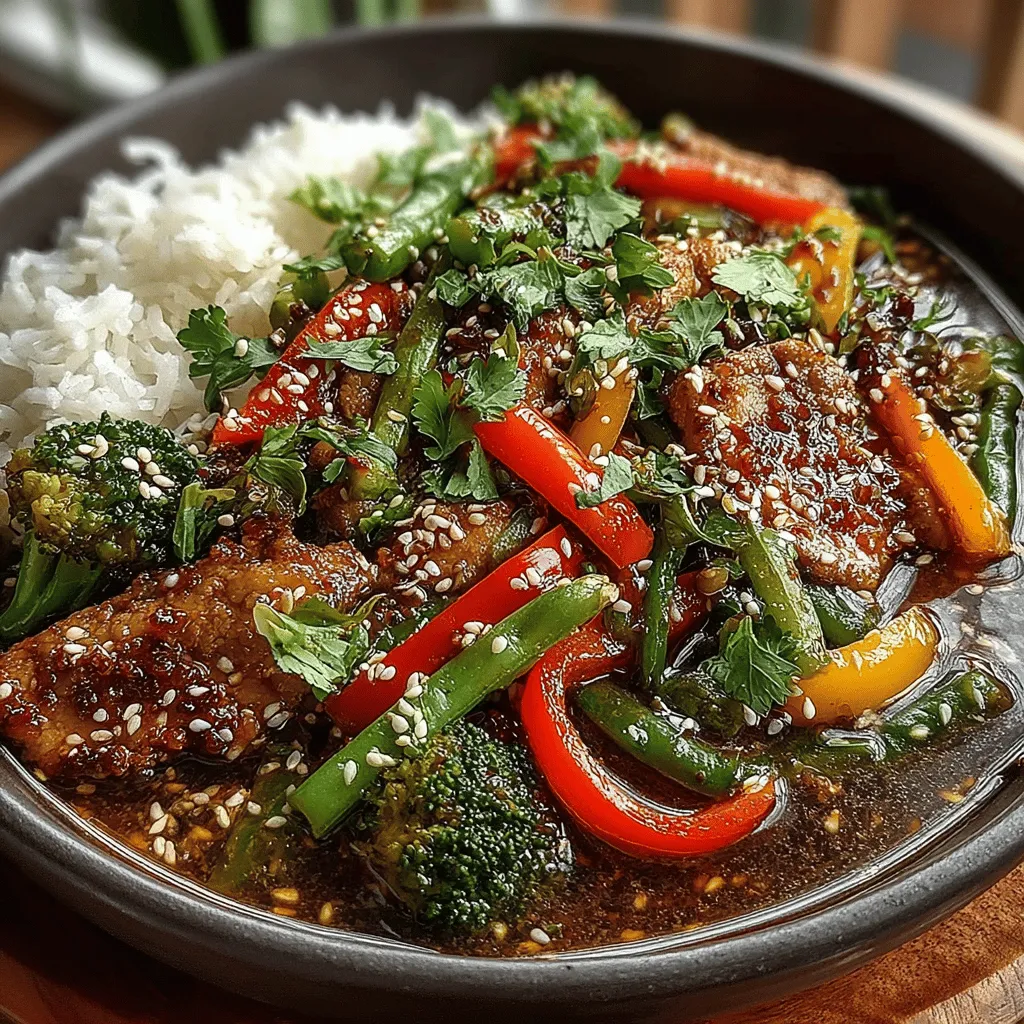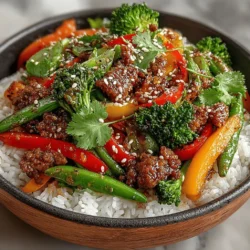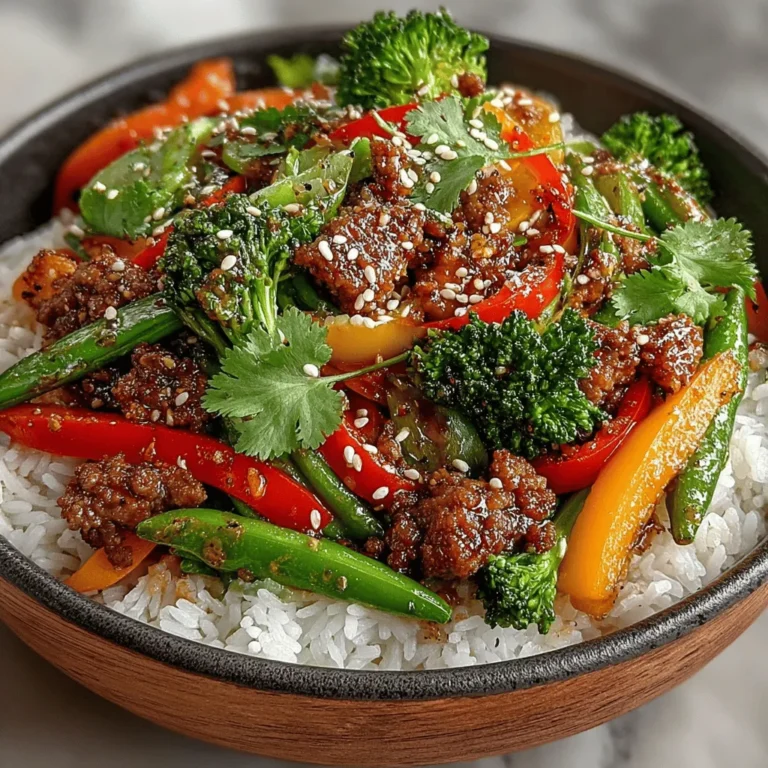Introduction
Savory Turkey and Vegetable Stir-Fry is a delightful dish that brings together the rich flavors of lean turkey and a vibrant array of vegetables in a quick, satisfying meal. This recipe not only tantalizes your taste buds but also serves as a nutritious option that can easily fit into a busy lifestyle. With its combination of protein and fiber-rich vegetables, this stir-fry is perfect for anyone looking to maintain a balanced diet without sacrificing flavor.
One of the standout features of this dish is its versatility. You can easily customize the vegetables and sauces to suit your personal preferences or whatever you have on hand. This adaptability makes it an excellent choice for weeknight dinners when time is limited, yet a home-cooked meal is still desired.
Using fresh ingredients is crucial when preparing this stir-fry. Fresh vegetables not only enhance the meal’s flavor but also boost its nutritional value, providing essential vitamins and minerals. Incorporating a colorful selection of vegetables ensures that you benefit from a range of nutrients, making every bite not just delicious but also healthful.
Understanding Stir-Fry: A Culinary Technique
Stir-frying is a cooking technique that involves quickly frying ingredients in a small amount of oil over high heat while stirring continuously. This method originated in ancient China, where it was used as a way to prepare meals quickly and efficiently. The technique allows for a wide variety of ingredients to be cooked rapidly, preserving their texture, color, and nutrients.
One of the main benefits of stir-frying is its speed. Dishes can often be prepared in under 30 minutes, making it an ideal cooking method for busy individuals and families. Additionally, because of the high heat used in stir-frying, the cooking time is short, which helps retain the nutrients in the vegetables. This means you can enjoy a meal that is not only quick to prepare but also rich in vitamins and minerals.
Stir-fry dishes typically consist of a protein source, such as chicken, beef, or turkey, combined with a variety of vegetables. Common ingredients include bell peppers, broccoli, carrots, and snap peas, among others. The use of aromatics like garlic and ginger enhances the flavor profile, while various sauces can be added to create a deliciously savory experience.
Ingredients Breakdown
The Savory Turkey and Vegetable Stir-Fry features a selection of fresh ingredients that not only contribute to its delicious flavor but also offer numerous health benefits.
Main Ingredients
1. Ground Turkey: This lean protein source is an excellent choice for those looking to reduce fat intake while still enjoying a hearty meal. Ground turkey is versatile and absorbs flavors well, making it perfect for stir-fry recipes.
2. Bell Peppers: These colorful vegetables add sweetness and crunch to the dish. They are rich in vitamins A and C, which are essential for skin health and immune function.
3. Carrots: Carrots provide a natural sweetness and are an excellent source of beta-carotene, which is vital for eye health. Their vibrant color also adds visual appeal to the stir-fry.
4. Broccoli: This nutrient-dense vegetable is known for its high levels of vitamins C and K, fiber, and various antioxidants. Its crunchy texture complements the tender turkey well.
5. Snap Peas: These sweet, crisp peas add freshness and a pop of color. They are low in calories but high in vitamins and minerals, making them a great addition to any dish.
Aromatics
– Garlic: A staple in many cuisines, garlic adds a distinctive flavor and aroma to the stir-fry. It is also known for its potential health benefits, including anti-inflammatory properties.
– Ginger: Fresh ginger contributes a zesty warmth that enhances the overall flavor of the dish. It is also recognized for its digestive benefits and can add a hint of spiciness.
Sauces
The flavor of the Savory Turkey and Vegetable Stir-Fry is further enhanced through the use of sauces:
– Low-Sodium Soy Sauce: This sauce brings umami flavor to the dish without adding excess sodium. It’s a great way to season the stir-fry while keeping it healthy.
– Oyster Sauce: Known for its rich flavor, oyster sauce adds depth to the dish. It pairs well with the other ingredients, creating a well-rounded taste.
– Sesame Oil: A few drops of sesame oil can elevate the stir-fry with its nutty aroma and flavor. It is often used as a finishing oil to give dishes a final touch.
Optional Ingredients
One of the advantages of stir-frying is the flexibility it offers. You can easily swap out or add ingredients based on your personal preferences or dietary restrictions. For instance, if you prefer a vegetarian option, you can replace the ground turkey with tofu or tempeh. Similarly, feel free to incorporate other vegetables like zucchini, mushrooms, or bok choy, depending on what you have available. This adaptability not only makes the dish more enjoyable but also encourages creativity in the kitchen.
Step-by-Step Cooking Instructions
Heating the Oil
The first step in making your Savory Turkey and Vegetable Stir-Fry is selecting the right cooking oil. For stir-frying, it is essential to use an oil with a high smoke point to withstand the high heat. Oils such as canola, peanut, or avocado oil are excellent choices due to their ability to reach high temperatures without burning.
Once you have your oil ready, heat it in a large skillet or wok over medium-high heat. Allow the oil to heat until it shimmers, indicating that it is hot enough for stir-frying. This step is crucial, as the right temperature will ensure that the turkey cooks quickly and evenly while retaining its moisture.
Now that you are prepared to continue with the cooking process, you are one step closer to enjoying a deliciously savory and nutritious meal. The combination of ground turkey and fresh vegetables will create a delightful dish that can be served over rice or noodles, making it a perfect addition to your weeknight dinner rotation.

Continuing the journey of creating a delicious Savory Turkey and Vegetable Stir-Fry, we will delve into the detailed steps necessary for perfecting this delectable dish. This section will guide you through browning the turkey, sautéing the aromatics, adding vibrant vegetables, incorporating sauces, and finishing touches that elevate the dish. We will also explore serving suggestions, nutritional information, and conclude with an appeal for culinary creativity.
Browning the Turkey: Tips on Achieving the Perfect Texture and Flavor
To achieve the ideal texture and flavor for your turkey, start by ensuring your pan is preheated over medium-high heat. Use a high-quality non-stick or cast-iron skillet, as these distribute heat evenly and help prevent sticking. Add a tablespoon of oil—preferably a neutral oil like canola or vegetable oil, which has a high smoke point.
Once the oil shimmers, add the ground turkey in an even layer. Avoid overcrowding the pan, as this can lead to steaming instead of browning. Let the turkey cook undisturbed for about 3-4 minutes to develop a golden-brown crust before stirring. This browning process not only enhances the flavor through the Maillard reaction but also creates a satisfying texture.
After browning the turkey, use a spatula to break it into smaller pieces and continue cooking for an additional 3-4 minutes until fully cooked through. Ensure there’s no pink remaining, as this indicates the turkey is safe to eat. Once cooked, remove the turkey from the skillet and set it aside, allowing the residual heat to keep it warm.
Sautéing Garlic and Ginger: The Importance of Timing in Cooking Aromatics
Once the turkey is set aside, return the skillet to the heat. Reduce the heat to medium and add another splash of oil if needed. The key to aromatic ingredients like garlic and ginger is timing. Add minced garlic and grated ginger to the pan, stirring constantly for about 30 seconds to 1 minute until fragrant. Be careful not to let them burn, as this can impart a bitter flavor to your stir-fry.
The aromatic nature of these ingredients adds depth to the dish, infusing the oil with their flavors. Once they are aromatic, it’s time to incorporate the colorful array of vegetables.
Adding Vegetables: Maintaining the Crunch and Vibrancy of Vegetables
For the vegetable component, select a mix of your favorites—bell peppers, broccoli, snow peas, and carrots work beautifully together. Aim for a variety of colors to make the dish visually appealing and nutritionally balanced.
Add the vegetables to the pan in stages, starting with those that take longer to cook. For instance, begin with broccoli and carrots, sautéing them for about 2-3 minutes. Next, add bell peppers and snow peas, stirring continuously. The goal is to cook the vegetables until they are tender-crisp, which usually takes about 2-4 minutes. This method ensures they retain their vibrant colors and essential nutrients, contributing to the overall healthiness of your stir-fry.
Incorporating Sauces: Balancing Flavors and Adjusting Seasoning
Once the vegetables are at the desired texture, it’s time to reintroduce the browned turkey to the skillet. Pour in your sauce mixture, which can include soy sauce, oyster sauce, and a splash of rice vinegar for acidity.
The key to a successful stir-fry is balancing flavors—sweet, salty, and umami. Taste the sauce and adjust the seasoning as necessary. If you prefer a sweeter profile, consider adding a teaspoon of honey or brown sugar. For an extra kick, a dash of chili sauce can be added to the mix.
Stir everything together, ensuring the turkey and vegetables are evenly coated with the sauce. This step is crucial, as it allows all the flavors to meld together, creating a cohesive dish.
Thickening the Sauce: Explanation of the Cornstarch Technique for Sauce Consistency
To achieve the perfect sauce consistency, a cornstarch slurry can be used. Mix one tablespoon of cornstarch with two tablespoons of cold water in a small bowl. Once well combined, add this slurry to your stir-fry while continuously stirring. The heat will activate the cornstarch, thickening the sauce almost immediately.
This technique not only enhances the texture of the sauce, making it cling beautifully to the turkey and vegetables, but it also helps to create a glossy finish that is visually appealing. Allow the mixture to bubble for another minute, ensuring the sauce thickens properly.
Finishing Touches: The Significance of Garnishing with Green Onions, Sesame Seeds, and Cilantro
As you prepare to serve your Savory Turkey and Vegetable Stir-Fry, the finishing touches are essential. Remove the skillet from the heat and sprinkle chopped green onions, toasted sesame seeds, and fresh cilantro over the top. These garnishes not only enhance the visual appeal but also provide a fresh burst of flavor.
The green onions add a mild onion flavor that complements the dish, while the sesame seeds contribute a nutty crunch. Cilantro brings a refreshing herbaceousness that ties the entire dish together.
Serving Suggestions
Recommended Accompaniments:
To create a well-rounded meal, serve your stir-fry over a bed of fluffy jasmine rice or protein-packed quinoa. The neutral flavors of these grains serve as an excellent canvas for the savory turkey and vegetable mixture.
Presentation Tips for an Appealing Dish:
Presentation plays a vital role in making your dish enticing. Layer the stir-fry over the rice or quinoa, allowing the vibrant colors of the vegetables to show through. Use a large spoon to create an inviting mound, and then garnish generously with the green onions, sesame seeds, and cilantro.
Variations of the Dish:
Feel free to personalize this stir-fry based on your preferences or dietary restrictions. For alternative proteins, consider using chicken, tofu, or shrimp. If you have specific vegetable preferences, swap in zucchini, mushrooms, or bok choy. Additionally, you can experiment with different sauces such as teriyaki or hoisin for a unique twist.
Nutritional Information
Overview of the Health Benefits of the Dish:
The Savory Turkey and Vegetable Stir-Fry is packed with protein, vitamins, and minerals. Turkey is a lean source of protein, low in fat, and rich in B vitamins which support energy metabolism. The variety of vegetables included add fiber, antioxidants, and essential nutrients to the dish, promoting overall health and wellness.
Discussion on Portion Sizes and Dietary Considerations:
When serving, a standard portion size is typically one cup of stir-fry over a half-cup of rice or quinoa. For those managing caloric intake or following specific dietary plans, consider adjusting your portion sizes accordingly. The dish is adaptable for various lifestyles—whether you’re following a low-carb, gluten-free, or vegetarian diet, simply substitute ingredients to meet your needs.
Balancing the Meal with Sides to Create a Complete Nutritional Profile:
To create a complete meal, consider serving the stir-fry with a side of steamed or roasted vegetables. This addition not only enhances the nutritional value but also contributes more color and flavor to your plate. A simple side salad with a light dressing can also complement the dish beautifully.
Conclusion
In summary, the Savory Turkey and Vegetable Stir-Fry is a simple yet delicious recipe that can be customized to suit any palate. The process of browning turkey, sautéing aromatics, and incorporating fresh vegetables creates a dish that is not only flavorful but also packed with nutrients.
This recipe’s adaptability makes it suitable for varying dietary needs and preferences, encouraging home cooks to explore their culinary creativity. Whether you stick to the original recipe or make it your own, this stir-fry is sure to become a staple in your kitchen. We invite you to try making this dish for yourself, embrace the cooking process, and enjoy the delightful flavors you create.


